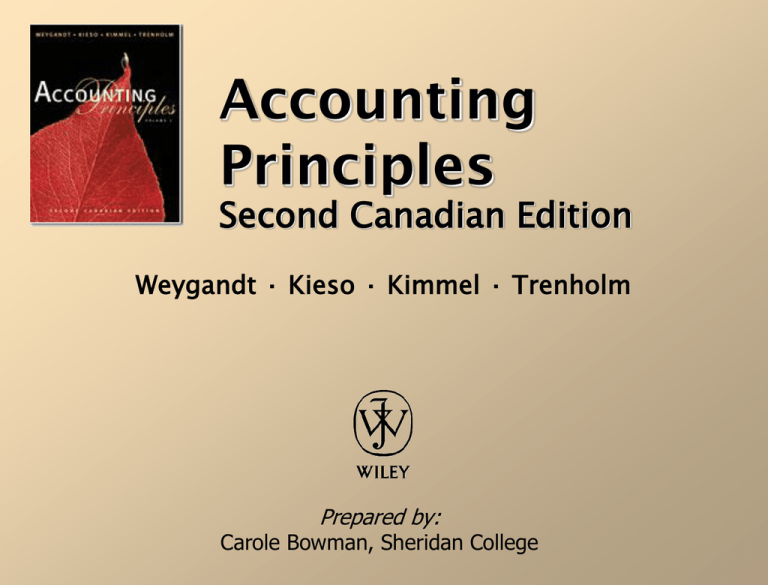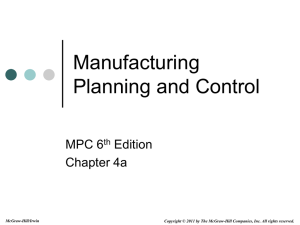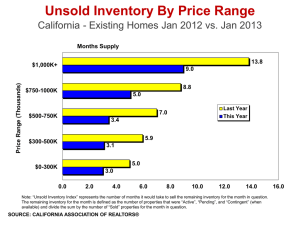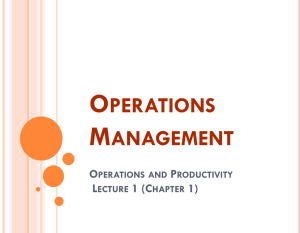
Accounting
Principles
Second Canadian Edition
Weygandt · Kieso · Kimmel · Trenholm
Prepared by:
Carole Bowman, Sheridan College
CHAPTER
6
INVENTORY COSTING
INVENTORY BASICS
In the balance sheet of merchandising and
manufacturing companies, inventory is
frequently the most significant current asset.
In the income statement, inventory is vital in
determining the results of operations for a
particular period.
Gross profit (net sales - cost of goods sold)
is closely watched by management,
owners, and other interested parties.
Perpetual vs. Periodic
Inventory Accounting
Perpetual
– Updates inventory and cost of goods sold
after every purchase and sales transaction
Periodic
– Delays updating of inventory and cost of
goods sold until end of the period
– Misstates inventory during the period
This chapter covers the periodic inventory method.
DETERMINING INVENTORY
QUANTITIES
In order to prepare financial statements, it is necessary
to determine the number of units of inventory owned by
the company at the statement date, and to value them.
The determination of inventory quantities involves
1. taking a physical inventory of goods on hand, and
2. determining the ownership of goods.
Taking a physical inventory involves counting,
weighing, or measuring each kind of inventory on hand.
TAKING A PHYSICAL INVENTORY
A company, in order to minimize errors in
taking the inventory, should adhere to
internal control principles by adopting the
following procedures:
1. Employees who do not have custodial
responsibility for the inventory should do
the counting (segregation of duties).
2. Each counter should establish the
authenticity of each inventory item
(establishment of responsibility).
TAKING A PHYSICAL INVENTORY
3. Another employee should make a second
count (independent verification).
4. All inventory tags should be pre-numbered
and accounted for (documentation
procedures).
5. At the end of the count, a designated
supervisor should ascertain that all
inventory items are tagged and that no
items have more than one tag
(independent verification).
TERMS OF SALE
FOB Shipping Point
FOB Destination Point
Seller
Seller
Ownership
passes to
buyer here
Public
Carrier
Co.
Buyer
Ownership
passes to
buyer here
Public
Carrier
Co.
Buyer
DETERMINING OWNERSHIP OF
CONSIGNED GOODS
Under a consignment arrangement, the
holder of the goods (called the consignee)
does not own the goods.
Ownership remains with the shipper of the
goods (consignor) until the goods are
actually sold to a customer.
Consigned goods should be included in the
consignor’s inventory, not the consignee’s
inventory.
Owned by a consignor; do not
count in our (consignee) inventory
Consignee Company
SALES TRANSACTIONS
General Journal
Date Account Title and Explanation
May 4 Accounts Receivable
Sales
To record credit sale.
Ref
Debit
3,800
J1
Credit
Only one entry is required to record a sale
under a periodic method.
3,800
RECORDING SALES RETURNS
AND ALLOWANCES
General Journal
Date Account Title and Explanation
May 8 Sales Returns and Allowances
Accounts Receivable
To record returned goods.
Ref
Debit
300
J1
Credit
300
The normal balance of Sales Returns and
Allowances is a debit. Sales Returns and
Allowances is a contra revenue account to the
Sales account.
PURCHASES OF
MERCHANDISE
General Journal
Date Account Title and Explanation Ref
May 4 Purchases
Accounts Payable
To record goods purchased on
account, terms n/30.
Debit
3,800
J1
Credit
3,800
For purchases on account, Purchases is
debited and Accounts Payable is credited. For
cash purchases, Purchases is debited and Cash
is credited.
PURCHASE RETURNS AND
ALLOWANCES
General Journal
Date Account Title and Explanation
May 8 Accounts Payable
Purchase Returns and Allowances
To record return of goods
Ref
Debit
300
J1
Credit
For purchases returns and allowances that were
originally made on account, Accounts Payable is
debited and Purchase Returns and Allowances is
credited. The Purchase Returns and Allowances
account is a contra account.
300
ACCOUNTING FOR FREIGHT COSTS
General Journal
Date Account Title and Explanation
May 4 Freight In
Cash
To record payment of freight.
Ref
Debit
150
When the purchaser directly incurs the
freight costs, the account Freight In is
debited and Cash is credited.
J1
Credit
150
HIGHPOINT ELECTRONICS
Income Statement
For the Year Ended December 31, 2002
Sales revenue
Sales
Less: Sales returns and allowances
Net sales
Cost of goods sold
Inventory, January 1
Purchases
Less: Purchase returns and allowances
Net purchases
Add: Freight in
Cost of goods purchased
Cost of goods available for sale
Inventory, December 31
Cost of goods sold
Gross profit
Operating expenses
Salaries expense
Rent expense
Utilities expense
Advertising expense
Amortization expense
Freight out
Insurance expense
Total operating expenses
Net income
$
$
$
$
$
480,000
20,000
460,000
$
316,000
144,000
36,000
325,000
17,200
307,800
12,200
320,000
$ 356,000
40,000
$
45,000
19,000
17,000
16,000
8,000
7,000
2,000
The multi-step income statement under the
periodic system requires more detail in the cost
of goods sold section, as shown above.
$
114,000
30,000
ALLOCATION OF
INVENTORIABLE COSTS
Ending
Inventory
(Balance
Sheet)
Beginning
Inventory
Cost of Goods
Available for Sale
Goods
Purchased
during the
year
Cost of Goods
Sold (Income
Statement)
USING ACTUAL PHYSICAL
FLOW COSTING
The specific identification method tracks the
actual physical flow of the goods.
Each item of inventory is marked, tagged, or
coded with its specific unit cost.
It is most frequently used when the company
sells a limited variety of high unit-cost items.
USING ASSUMED COST
FLOW METHODS
Other cost flow methods are allowed since
specific identification is often impractical.
These methods assume flows of costs that
may be unrelated to the physical flow of
goods.
Cost flow assumptions:
1. First-in, first-out (FIFO).
2. Average cost.
3. Last-in, first-out (LIFO).
FIFO
The FIFO method assumes that the earliest
goods purchased are the first to be sold.
Often reflects the actual physical flow of
merchandise.
Under FIFO, the costs of the earliest goods
purchased are the first to be recognized as
cost of goods sold. The costs of the most
recent goods purchased are recognized as
the ending inventory.
FIFO method assumes earliest
goods purchased are the first to
be sold
AVERAGE COST
The average cost method assumes that the
goods available for sale are homogeneous.
The allocation of the cost of goods
available for sale is made on the basis of
the weighted average unit cost incurred.
The weighted average unit cost is then
applied to the units sold to determine the
cost of goods sold and to the units on hand
to determine the ending inventory.
Allocation of the cost of goods
available for sale in average cost
method is made on the basis of
the weighted average unit cost
Average cost method assumes that
goods available for sale are
homogeneous
LIFO
The LIFO method assumes that the latest
goods purchased are the first to be sold
and that the earliest goods purchased
remain in ending inventory.
Seldom coincides with the actual physical
flow of inventory.
Under the periodic method, all goods
purchased during the year are assumed to
be available for the first sale, regardless of
date of purchase.
Rarely used in Canada.
LIFO method assumes latest goods
purchased are the first to be sold
INCOME STATEMENT EFFECTS
In periods of rising prices, FIFO reports the
highest net income, LIFO the lowest and
average cost falls in the middle.
The reverse is true when prices are
falling.
When prices are constant, all cost flow
methods will yield the same results.
BALANCE SHEET EFFECTS
FIFO produces the best balance sheet
valuation since the inventory costs are closer
to their current, or replacement, costs.
USING INVENTORY COST FLOW
METHODS CONSISTENTLY
A company needs to use its chosen cost
flow method consistently from one
accounting period to another.
Such consistent application enhances the
comparability of financial statements over
successive time periods.
When a company adopts a different cost
flow method, the change and its effects on
net income should be disclosed in the
financial statements.
INVENTORY ERRORS - INCOME
STATEMENT EFFECTS
Both beginning and ending inventories appear
on the income statement.
The ending inventory of one period
automatically becomes the beginning
inventory of the next period.
Inventory errors affect the
determination of cost of goods
sold and net income.
FORMULA FOR
COST OF GOODS SOLD
Beginning
Inventory
+
Cost of _ Ending
Goods
Inventory
Purchased
=
Cost of
Goods
Sold
The effects on cost of goods sold can be
determined by entering the incorrect data
in the above formula and then substituting
the correct data.
EFFECTS OF INVENTORY
ERRORS ON CURRENT YEAR’S
INCOME STATEMENT
In ven to ry E rro r
C o st o f
G o o d s S o ld
Understate beginning inventory Understated
Overstate beginning inventory
Overstated
Understate ending inventory
Overstated
Overstate ending inventory
Understated
N et In co m e
Overstated
Understated
Understated
Overstated
An error in ending inventory of the current period
will have a reverse effect on net income of the next
accounting period.
ENDING INVENTORY ERROR –
BALANCE SHEET EFFECTS
The effect of ending inventory errors on the
balance sheet can be determined by using the
basic accounting equation:
Assets = Liabilities + Owner’s Equity
E n d in g In ven to ry
E rro r
Overstated
Understated
Assets
Overstated
Understated
L iab ilities
None
None
O w n er’s E q u ity
Overstated
Understated
VALUING INVENTORY AT THE
LOWER OF COST AND MARKET
When the value of inventory is lower than
the cost, the inventory is written down to
its market value.
This is known as the lower of cost and
market (LCM) method.
Market is defined as replacement cost or
net realizable value.
ILLUSTRATION 6-20
ALTERNATIVE LOWER OF COST
AND MARKET (LCM) RESULTS
Cost
Television sets
Consoles
$
Portables
Total
Video equipment
Recorders
Movies
Total
Total inventory
$
Market
60,000
45,000
105,000
$
48,000
15,000
63,000
168,000
45,000
14,000
59,000
$ 166,000
LCM
55,000
52,000
107,000
$ 166,000
The common practice is to use total inventory
rather than individual items or major
categories in determining the LCM valuation.
COPYRIGHT
Copyright © 2002 John Wiley & Sons Canada, Ltd. All rights reserved.
Reproduction or translation of this work beyond that permitted by
CANCOPY (Canadian Reprography Collective) is unlawful. Request for
further information should be addressed to the Permissions Department,
John Wiley & Sons Canada, Ltd. The purchaser may make back-up copies
for his / her own use only and not for distribution or resale. The author and
the publisher assume no responsibility for errors, omissions, or damages,
caused by the use of these programs or from the use of the information
contained herein.









